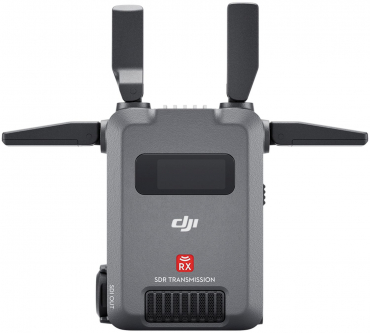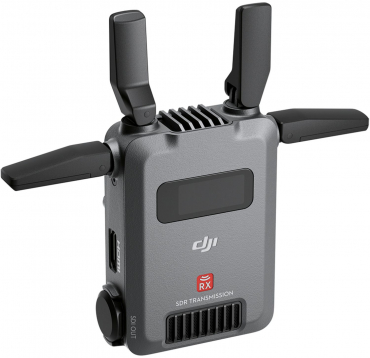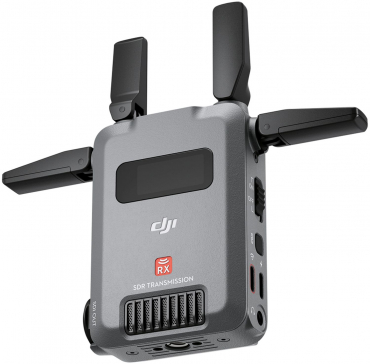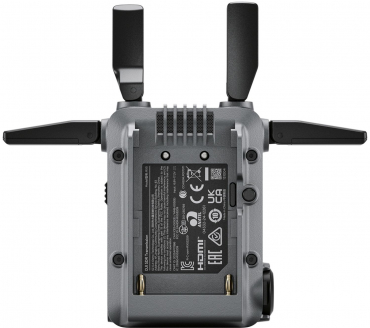DJI SDR Transmission Receiver
SDR Transmission, Strong and Stable
DJI SDR Transmission is based on Software Defined Radio technology and utilizes both SDR and Wi-Fi video transmission modes. SDR technology takes video transmission performance to a whole new level, offering greater stability, interference resistance and penetration capability. In time-limited situations, DJI SDR Transmission also offers the option of Wi-Fi transmission to provide more flexibility for workers.
SDR vs. Wi-Fi
Transmission range Increased by 650%
Transmission bit rate Increased by 67%
Transmission latency Improved by 30%
Kilometre transmission rangeTransmission, robust penetration
DJI SDR Transmission has a range of up to 3 km [1] and is suitable for long-range, dynamic filming scenarios. With outstanding penetration capability, it meets the requirements for live feed monitoring on location in a variety of complex scenarios.
20 Mbps high bit rate, 1080p FHD image quality
DJI SDR Transmission supports 1080p/60fps live feeds with a high bit rate of up to 20 Mbps [2], ensuring smooth monitoring and cooperation.
Seamless automatic frequency switching
DJI SDR Transmission supports automatic switching between the 2.4 GHz, 5.8 GHz and DFS frequency bands. In case of interference, it can automatically switch to the optimal channel to easily handle complex environmental conditions.
Unlimited number of receivers
In broadcast mode, each transmitter can be connected to an unlimited number of receivers, enabling high-quality monitoring for multiple workers and meeting the independent monitoring requirements of different professional roles.
Additional functions
35 milliseconds, low latency transmission
The minimum latency of just 35 ms [3] ensures smooth monitoring and efficient collaboration.
DJI SDR Transmission supports the transmission of metadata from popular cinema cameras such as ARRI and RED via SDI.
*This allows directors, camera operators and DIT teams to quickly access detailed shooting information in real time.
Communicate with voice call
DJI SDR Transmission enables direct, real-time communication [4] between receiver and transmitter, allowing seamless conversations between cinematographer and director or client at any time.
Agile and innovative surveillance
Compact, lightweight and portable
Thanks to the lightweight design and foldable antennas for easy storage, a single transmitter or receiver weighs approximately 145g [5]. This not only ensures portability, but also supports various mounting methods to meet different site requirements.
Innovative USB-C connection, multiple monitoring methods
DJI SDR Transmission supports multiple monitoring methods and can output three SDR signals and two Wi-Fi signals simultaneously. The receiver can be output to monitors via SDI/HDMI. In addition, the transmitter can be directly connected to smartphones or tablets via Wi-Fi, providing cost-effective two-channel monitoring without the need for a receiver.
DJI SDR Transmission also introduces a monitoring method for USB-C output, combining stability with convenience. Receivers can be connected to a smartphone or tablet for smooth and stable monitoring.
Newly updated DJI Ronin app
Switching camera index
When DJI SDR Transmission is connected to the DJI Ronin app in broadcast mode, you can seamlessly switch between camera indexes within the app to meet the monitoring needs for different camera views.
Local recording and playback
The app supports local recording, and recorded content can be reviewed on the playback page.
Multiple monitoring options
The app supports common monitoring assistance tools such as LUT, peaking, waveform and false color, providing a professional monitoring experience.
Supporting features
Control for RS series stabilizers [6]
Supports Force Mobile, virtual joystick and gimbal realignment functions.
Channel settings
When DJI SDR Transmission is connected to the app in SDR Control mode or Wi-Fi mode, you can change the channel within the app and monitor the channel quality at the same time.
Camera control
DJI SDR Transmission supports PTP control of cameras, displaying and adjusting the aperture, shutter, ISO and even triggering the camera's photo and video recording functions via the app. It also supports CEC control for Sony cameras, which brings the mirror control mode into play.
Comprehensive connectivity and power solutions
DJI SDR Transmission Connectors for receiver
USB-C port
USB-C port for firmware update and video output
USB-C port USB-C
power port
3.5 mm stereo jack
Supports one-on-one voice calls. [4]
HDMI output
Supports video and audio output at 1080p/60fps.
SDI output
Supports video and audio output at 1080p/60fps.
Versatile and customized power supply options
Gimbal Power
Thanks to the integrated power supply, the transmitter can be mounted on and powered directly from the gimbal when using the DJI RS 4 Pro, DJI RS 4 or DJI RS 3 Pro [7], eliminating the need for a separate battery.
Alternative power supply options
Power supply with NP-F
Both the transmitter and receiver support industry-standard NP-F batteries, which deliver a voltage of 6.8 to 8.4 V.
USB-C power supply
DJI SDR Transmission has expanded compatibility. It can be powered by a standard PD protocol charger with a USB-C power input of 9V and 2A.




Simply subscribe and benefit as a newsletter recipient every week: